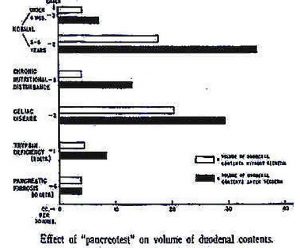PANCREAS
See also MALABSORPTION TOPIC
1941 Beazell JM, Schmidt CR, Ivy AC. The diagnosis and treatment of achylia pancreatica. J Am Med Assoc 1941; 116:2735-2739.
This classic paper, from Professor Ivy’s group, was said to initiate the modern treatment of pancreatic insufficiency. At the start, the authors state “Since the number of well studied patients are few and since oral pancreatic enzyme therapy in man is not generally considered to be of value, a view that is inconsistent with most of the results with animal experiments, we have undertaken to determine the effectiveness of oral pancreatic enzyme therapy in human patients with achylia pancreatica”.
Four patients with pancreatic insufficiency were studied in detail with estimation of faecal fat and nitrogen and also estimation of their duodenal enzymes – which were totally absent. Enzyme replacement therapy resulted in an average reduction in daily faecal nitrogen excretion of 62% (7.84 to 2.99 g) and lipids of 63.3% (74.4 to 27.3 g). All the patients gained weight (6 to 40 lbs) over 2.5 to 36 months. The authors note that Dorothy Andersen had already shown that pancreatic enzyme therapy improved the intestinal malabsorption of children with cystic fibrosis (Andersen DH. J Pediatr 1939; 15:763).
 |
| Professor Ivy. From The Paradox of the Pancreas. With permission of Professor Irvin Modlin. |
Professor AC Ivy (1893-1978) (figure 1) was a famous physiologist who, with Oldberg, discovered cholecystokinin in 1928 and apparently published some 2000 scientific articles. There was considerable discussion for many years among paediatricians as to whether pancreatic replacement therapy was worth using – some paediatricians considered that the unpleasant taste of the crude pancreatic extract did more harm than good in putting children off their food to achieve only modest improvements in absorption. However, all agreed that the introduction of the acid resistant microspheres (Pancrease and Creon) in the early Eighties represented a major advance in treatment.1942 Andersen DH. Pancreatic enzymes in duodenal juice in celiac syndrome. Am J Dis Child 1942; 63:643.
The first suggestion that estimation of duodenal trypsin was a reliable diagnostic test for CF as there was a wide difference between the concentration of trypsin in CF and in other gastrointestinal conditions and controls. Andersen noted that in normal infants trypsin and lipase were present from birth and amylase from 2 or 3 months.
Trypsin was more reliable than lipase although levels of the enzymes may be reduced in marasmus or severe dehydration; this was also noted by Shwachman and was confirmed many years later as a temporary phenomenon in gluten-induced coeliac disease, when it was attributed to lack of substrate to form the enzymes as a result of severe malnutrition (Carroccio A et al, Gut 1991; 32:796-799).
1943 Farber S, Shwachman H, Maddock CL. Pancreatic function and disease in early life. I. Pancreatic enzyme activity and the celiac syndrome. J Clin Invest 1943; 20:827-833. [PubMed]
One of a series of papers from Boston by Sidney Farber (figure 2) around this time discussing the differentiation between coeliac disease and cystic fibrosis – largely based on the enzyme content of the duodenal fluid to document and extend the conclusions of their preliminary report (Farber & Maddock, Am J Pathol 1941; 17:445). They used data from over 150 children – either normal controls or with various nutritional disturbances, idiopathic coeliac disease or pancreatic fibrosis.
The differentiation of pancreatic fibrosis from coeliac disease had taken on a new importance since the description of CF in 1938 as the prognosis for the two conditions was very different. They suggested differentiation of children with gastrointestinal features of coeliac syndrome into those with normal pancreatic function and those with abnormal pancreatic function – the later being a permanent fatal condition. Pancreatic achylia was a constant feature of those subsequently found to have pancreatic fibrosis at autopsy.
There was a clear separation of those with and without pancreatic fibrosis. So measurement of the pancreatic enzyme activity was considered mandatory for diagnosis of pancreatic fibrosis. Removal of 70-80% of the pancreas reduced the enzyme activity but did not produce pancreatic insufficiency (a finding later confirmed by DiMagno et al, 1973 below). Also Andersen (1942 above) had suggested duodenal trypsin as a reliable test for differentiating CF from coeliac disease.
 |
| Sidney Farber. From Wikipedia. |
This was one of Harry Shwachman’s (1910-1986) earlier papers as co-author and he would become one of the leading authorities on CF for many years to come.
1943 Shohl AT, May CD, Shwachman H. Studies of nitrogen and fat metabolism on infants and children with pancreatic fibrosis. J Pediatr 1943; 23:267-279.
A study of nine patients with cystic fibrosis. The striking feature of the infants with CF was the excess of nitrogen found in the faeces when normal diets were eaten, the patients remaining in negative nitrogen balance. Average weight of dried faeces/day – Normal infants 7.3 g – CF infants 33.4 g. Average nitrogen content of faeces/day – Normal infants 0.39 g – CF infants 1.7 g. Average fat content of dried faeces/day – Normal infants 3.1 g – CF infants 16.8 g. On a fat-free diet of casein hydrolysate and glucose, nitrogen retention was in the normal range and excretion normalised. The authors concluded that hydrolysed casein could be utilised in contrast to whole protein.
Subsequently feeds containing hydrolysed protein (e.g. Pregestimil) were shown by others to prove useful in improving malabsorption in some infants with CF where control of the malabsorption has proved difficult – particularly after meconium ileus operations and with cow’s milk intolerance. The concept of an elemental diet, which required less digestion, to improve absorption was also later pioneered by Jimmy Allen, a general paediatrician in Macclesfield, England (Allan JD et al, 1970 and 1973 below) and created considerable interest in the Seventies when it was almost impossible to maintain a normal nutritional state as the children became older and their chest became progressively worse.
1943 Maddock CL, Farber S, Shwachman H. Pancreatic function and disease in early life. II. Effect of secretin on pancreatic function of infants and children. Amer J Dis Child 1943; 66:370 – 375.
These workers from Boston noted that the hormone secretin (discovered by Bayliss and Starling in 1902) had been used to stimulate pancreatic secretion only in adults up to that time. So they performed 26 secretin stimulation tests on 21 young patients and found trypsin was absent from the duodenum after intravenous stimulation by secretin in the 7 children with cystic fibrosis. They noted that in non-CF children “the increased flow of duodenal juice that followed the injection of secretin occurred in 3 – 5 minutes. Often the pancreatic flow was so copious that the bile coloring of the duodenal fluid was diluted so that fluid was colourless by the end of twenty minutes at which time the flow rate diminished. The most striking feature was the small volume of pancreatic juice obtained in patients with pancreatic fibrosis and the apparent failure of secretin to stimulate pancreatic flow in these patients in the “pancreatic fibrosis” group. (figure 3).
 |
| Effect of “Pancreotest” on the volume of duodenal contents. |
More extensive studies on pancreatic function in CF with secretin and pancreozymin were later reported by others – notably by Hadorn et al, 1968 (below) and these are usually quoted when discussing the subject; even more recently the subject was studied by Kopleman et al in Toronto (N Eng J Med 1985; 312:329-334 below). All have found markedly reduced fluid and bicarbonate output in all patients with CF and in the majority a reduced enzyme output.
1943 Shwachman H, Farber S, Maddock CL. Pancreatic function and disease in early life. III. Methods of analysing pancreatic enzyme activity. Am J Dis Child 1943; 66:418.
This is a description of the two methods of measuring tryptic activity – the tube method and gelatin method. One of series of papers with Sydney Farber regarding the investigation of pan
1948 Sinclair W Jr. Cystic fibrosis of the pancreas. Ohio Med J 1948; 44:1024.[PubMed]
This paper is mentioned as the first report of partial pancreatic involvement in a later report by Gibbs et al, 1950 (below). Autopsy diagnosis of an infant aged five months with CF in whom approximately one half of the pancreas, and that mostly in the tail, appeared to be involved. The infant had a normal concentration of trypsin in the duodenal aspirate and a normal output of stool fat. The usual bronchitis and bronchopneumonia expected with CF were the cause of death.
1949 Shwachman H, Patterson PR, Laguna J. Studies in pancreatic fibrosis: Simple gelatin film test for stool trypsin. Pediatrics 1949; 4:222-230. [PubMed]
In this paper previous work on stool trypsin was reviewed, even as far back as the first duodenal catheterisation by Hess AF (Am J Dis Child 1912; 4:205). Faecal suspensions were placed upon unexposed and unfixed gelatin film and the extent of removal (digestion) of the gelatin film noted. The gelatin was digested by the trypsin in the stool in more than 95% of non-CF infants whereas 209 of 220 (95%) of stool specimens from untreated infants with CF showed no tryptic activity whereas less than 5% of 500 controls lacked tryptic activity. Three separate stool specimens were recommended for diagnosis.
 |
| Stool suspensions on gelatine plate |
A photograph in the paper shows gelatin film acted upon by stool suspensions from three individuals. Concentrations of 1/5 on upper row and 1/10 are on the lower row being the more dilute (figure 4).
1- Normal infant’s stool with extensive white areas where there has been extensive digestion of the gelatin by the trypsin in the stool..
2- Infant with cystic fibrosis – no digestion of gelatin.
3- CF infant on treatment with pancreatin now digesting gelatin.
Subsequent papers on the gelatin film tests discussed problems with interference from faecal bacteria digesting the gelatin on the film (e.g. Johnstone DE, Neter E. Pediatrics 1951; 7:483-490. [PubMed]). Bodian (1952) notes that Dorothy Andersen was the first to suggest testing for stool trypsin – an extremely important test prior to the availability of the sweat test for there were difficulties in duodenal intubation in small infants to obtain fluid for trypsin estimation.
Before the sweat test became available during the Fifties, demonstration of a pancreatic enzyme abnormality was mandatory in making a correct diagnosis of CF (which was essentially a death sentence for the infant) and differentiating the condition from coeliac disease from which the infant may recover. Duodenal intubation to measure tryptic activity was the method used and recommended by Dorothy Andersen.
1950 Gibbs GE, Bostick WL, Smith PM. Incomplete pancreatic deficiency in cystic fibrosis of the pancreas. J Pediatr 1950; 37:320-325. [PubMed]
A series of 38 patients included two proved at autopsy to have CF (by having typical pancreatic histological changes), but with sufficient residual pancreatic exocrine function to achieve normal fat absorption in life. Investigation showed the reduction in pancreatic enzymes was not complete. Possibly another four patients were in this category (13% of the series).
Subsequently it was shown that pancreatic enzyme output could fall to only 10% of normal before intestinal malabsorption occurred (DiMagno et al. 1973 below). The authors mention the previous case report of incomplete pancreatic involvement by Sinclair W Jr, 1948 (above). Also there were soon reports of similar patients who were described as “pancreatic sufficient” i.e. they had sufficient residual pancreatic function to achieve normal fat absorption (Shwachman et al 1952 & 1956 below; di Sant’Agnese al, 1956 below).
1951 Johnstone DE, Neter E. Studies on laboratory diagnosis of cystic fibrosis of the pancreas: Positive gelatine film tests due to gelatine-liquefying bacteria in feces and duodenal juice. Pediatrics 1951; 7:483-490.[PubMed]
A report suggesting that gelatine-liquefying bacteria would interfere with the reliability of the gelatine film test for faecal trypsin which had been described recently by Shwachman (Shwachman et al, 1949 above) and had seemed such a welcome alternative to duodenal aspiration. The authors suggested this complication was related to the increasing frequency of organisms, particularly Pseudomonas aeruginosa, in the stools which they suggested was related to the more prolonged use of antibiotics. Johnstone later showed that if a dilution of faeces of 1 in 120 was used the results were reliable (Johnstone, 1952 below).
This test was very important at the time as the sweat abnormality was not described until 1953 and the sweat tests not widely available until the Sixties. So at this time the diagnosis of CF relied heavily on the clinical picture and the absence of tryptic activity either in the duodenal aspirate or in the stools to identify the pancreatic abnormality.
1952 Shwachman H, Leubner H, Patterson P, Weill CC. Mucoviscidosis with partial pancreatic insufficiency. Am J Dis Child 1952; 84:763-765. [PubMed]
Previously some people with CF had escaped diagnosis as the duodenal trypsin test gave normal results. Progressive loss of pancreatic activity could be shown. Partial pancreatic insufficiency could be demonstrated by various techniques – examining duodenal fluid for various enzymes, viscosity and pH. In the discussion the need to differentiate the various causes of coeliac syndrome was stressed as some coeliac children were being falsely labelled as CF as a result of “the present interest in the cystic fibrosis”. For many years a frequent examination question for medical students was to list the differences between coeliac disease and cystic fibrosis; just as they must know the differences between children with hypothyroidism and Down’s syndrome.
By 1952 Shwachman had obviously become cautious about using secretin intravenously for pancreatic function tests as he warns that secretin “may occasionally produce disastrous effects…..usually not a purified substance….some children are allergic to it”. So although 10 years previously Shwachman had presented a study of secretin pancreatic stimulation tests in children (Maddock et al, 1943 above), he now preferred olive oil as a stimulant and believed “The most reliable diagnostic procedure is study of the duodenal fluid” (also Gibbs et al, 1950 above).
One of a number of papers discussing the estimation of faecal tryptic activity as an indication of pancreatic function, suggesting that absence of tryptic activity in the first few days suggested cystic fibrosis.
It is not surprising that there were a number of papers published on this subject as this was an important test in differentiating CF from coeliac disease in the days before the sweat test became more widely available during the late Fifties and Sixties.
1952 Johnstone DE. Studies on cystic fibrosis of pancreas: role of various diluents and the dilution factor in interpretation of X-ray film test for fecal trypsin. Am J Dis Child 1952; 84:191-198.
An astonishing 9,600 tests on 963 stool specimens from 216 children! Johnstone had already published on false negativity with the stool gelatine test due to bacterial digestion of the gelatine (Johnstone & Neter, 1951 above). However, in this study he showed that false results did not occur if a 1/120 dilution of the stool was used.
This test was still very important for diagnosis in 1952, as the sweat test was not yet available and duodenal intubation and aspiration was invasive, unpleasant for the infant, and difficult for the nursing and medical staff.
1955 di Sant’Agnese PA. Fibrocystic disease of the pancreas with normal or partial pancreatic function: current views on pathogenesis and diagnosis. Pediatrics 1955; 15:683-697.[PubMed]
Another early report of “pancreatic sufficient” patients i.e. defined as those who had sufficient remaining pancreatic function (probably around 10%) to achieve normal intestinal fat absorption without enzyme replacement therapy. On testing, six had partial pancreatic deficiency and 3 normal pancreatic function. These patients provide further evidence that the secretory activity of many and perhaps all exocrine glands, mucus producing and others, is affected rather than the clinical manifestations being due primarily to pancreatic disease and secondary malnutrition e.g. vitamin A deficiency. (See also Gibbs et al, 1950 above; Shwachman et al, 1956 below).
1956 Dooley RR, Guilmette F, Leubner H. Patterson PR, Shwachman H, Weil C. Cystic fibrosis of the pancreas with varying degrees of pancreatic insufficiency. J Dis Child 1956; 92:347-368. [PubMed]
A further 17 patients and an estimate that some 10-15% of patients were “pancreatic sufficient” i.e. had sufficient residual exocrine pancreatic function to achieve normal fat absorption. Chest disease may develop before malabsorption occurs thus supporting the original hypothesis of Wolbach and Farber of a generalised disease if modified to include disturbance of sweat glands as an almost constant feature – in contrast to the belief that the problems were secondary to pancreatic malabsorption and malnutrition e.g. vitamin A or other deficiencies. Only one patient had a sweat test performed and that was positive – the sweat abnormality having only been described recently in 1953 (also Gibbs et al. 1950 above; Di Sant’Agnese, 1955 above).
1957 Fyfe W M. The stool proteolytic activity in the diagnosis of fibrocystic disease of the pancreas. Scot Med J 1957; 2:66 – 68. [PubMed]
Probably the first paper on CF from Scotland – Royal Hospital for Sick Children Glasgow – testing Shwachman’s suggestion that measurement of stool proteolytic activity could replace duodenal intubation in the diagnosis of cystic fibrosis (Shwachman et al, 1949 above). Both duodenal and stool proteolytic activity were examined in 50 infants; 14 infants had absent proteolytic activity and were considered to have CF – confirmed at autopsy in eight. Fyfe concluded that liquefaction of the 1 ml of 7.5% gelatin by a 1:40 or higher dilution of stool was a reliable indication of normal duodenal proteolytic activity.
The author thanks Prof. Stanley Graham and Dr (later Prof) James Hutchinson for help and permission to study their cases – both were leading paediatricians in the UK at the time.
1963 Rick W. Untersuchung zur exokrinen function des pancreas bei zysticher pancreas-fibroses. (Pancreatic exocrine function in CF of the pancreas). Medizinische Welt 1963; 42:2158-9.
An early report of pancreatic function in CF showing reduced volume and reduced bicarbonate secretion. (Quoted by Wong LTK et al, Gut 1982; 23:744-750). Also pancreatic function was reported by Maddock et al, 1943 (above), Kopleman et al, 1985 (below) and Hadorn et al, 1968 (below). Hadorn’s work seemed to have had more impact (possibly as published in English) and is generally regarded as making the major contribution to pancreatic function testing in people with cystic fibrosis.
1964 Shwachman H, Diamond LK, Oski FA, Khaw Kon-T. The syndrome of pancreatic insufficiency and bone marrow dysfunction. J Pediatr 1964; 65:645-656. [PubMed]
This is the second most frequent cause of chronic pancreatic disease in children. Six children are described with what became known as the Shwachman–Diamond Syndrome. It is one of a number of conditions eventually recognised as separate entities from cystic fibrosis. The authors advised that the condition should be considered in children at first suspected of having CF but who had repeatedly normal sweat electrolytes. In 1967 Burke and colleagues (Burke V et al. Arch Dis Child 1967; 42:147-157.[PubMed]) reported 19 children with the condition from Royal Children’s Hospital Melbourne having published a preliminary report in 1965 (Colebatch JH et al Lancet 1965; ii: 496). Burke et al commented that in 1964 Bodian et al (Acta Paediatr Uppsala 1964; 53:282-93.[PubMed]) from Great Ormond Street, London had described two children with congenital hypoplasia of the exocrine pancreas both of whom had variable neutropenia and thrombocytopenia but which “did not receive special comment” – which is not entirely true. Bodian et al did however provide a useful review of a previous 18 histologically proven cases in the literature.
This was an important paper for paediatricians dealing with children who had CF as it identified a specific condition (exocrine pancreatic insufficiency, bone marrow dysfunction, skeletal abnormalites and short stature with normal sweat tests) likely to be encountered in specialist CF centres. In fact we identified five such children with the Shwachman-Diamond syndrome in Leeds over 20 years in the course of investigation of children considered initially to have cystic fibrosis.
1966 Barbero GJ, Siblinga MS, Marino JM, Seibel R. Stool trypsin and chymotrypsin. Value in the diagnosis of pancreatic insufficiency in cystic fibrosis. Am J Dis Child 1966; 112:536-540.[PubMed]
These are useful non-invasive tests for confirming pancreatic insufficiency used for many years – chymotrypsin being preferred to trypsin as it is the more stable. Their value was confirmed in subsequent reports (Brown et al, 1988 below). This present study used the method of Haverbach BJ, et al, (Gastroenterol 1963; 44:588-597). There was clear separation of CF and non-CF and the authors concluded it to be reliable in identifying those children with cystic fibrosis. Chymotrypsin values were : in CF < 58 ug/g and in non-CF > 75 ug/g stool and trypsin: in CF < 30 ug/g and in non-CF >80 ug/g stool
1968 Hadorn B, Zoppi G, Shmerling DH, Prader A, McIntyre I, Anderson CM. Quantitative assessment of exocrine pancreatic function in infants and children. J Pediatr 1968; 73:39-50. [PubMed]
One of a number of papers by Hadorn et al on stimulated pancreatic function in CF using a triple lumen tube. The method was used in a few CF Centres, including our own in Leeds, during the Seventies, but it was a difficult test to perform and very invasive for the children. The findings in the present group of 10 children with CF were a low volume of fluid and low bicarbonate output even when the enzyme concentrations were not markedly reduced.
After intravenous injection of pancreozymin (P) bile stained juice high in enzymes is secreted. After secretin (S) injection the volume and bicarbonate concentration is increased but the enzyme concentrations are reduced. In CF the secretion of both is markedly reduced (figure 5).
Also from the same group Zoppi G et al. (Helvet Paediatr Acta 1968; 6:577-590. [PubMed]) found a higher protein content in the pancreatic juice of both CF and non-CF pancreatic insufficiency using electrophoresis.
 |
| Pancreozymin-secretin pancreatic function test in a normal person as described by Hadorn. From Paediatric Gastroenterology, C M Anderson, V Burke (eds). Blackwell Scientific Publications, Oxford. 1973: 302. |
1968 Hadorn B, Johansen PG, Anderson CM. Pancreozymin secretin tests of exocrine pancreatic function in cystic fibrosis and the significance of the result for the pathogenesis of the disease. Can Med Ass J 1968; 98:377-85. [PubMed]
Thirteen of 176 children with CF in the Melbourne clinic had normal fat excretion. Ten of these pancreatic sufficient patients (PS) had pancreozymin-secretin tests confirming that the water and bicarbonate secretion from the pancreas was more severely affected than the enzyme secretion. They secreted small volumes of pancreatic juice with very low bicarbonate content and but abnormally high enzyme concentrations.
Evidence was presented that the pathological features in the pancreas could result from a failure to produce an adequate amount of electrolyte containing fluid. In text the authors make the following important comments “it is possible that this (the extensive changes in the pancreas) is at least partially caused by the “organic fraction” which is abnormally concentrated in enzymes. Although proteolytic enzymes are originally present in an inactive form in pancreatic juice it is not unlikely that they may become activated if the flow of secretion is markedly reduced or stagnates. Furthermore, because the secretion is more concentrated and more viscous, blockage of tubules followed by dilatation of the acini may lead to their rupture, and the intraluminal material containing activated enzymes could spread into the surrounding tissue causing irritation and destruction followed by atrophy and fibrosis of parts of the pancreas or entire organ”
This is a very attractive suggestion and likely to be the correct explanation for the early onset of the pancreatic damage starting with the electrolyte/fluid abnormality, now (but not then) known to be related to abnormalities of fluid and electrolyte transport across the cell membranes and analogous to the changes occurring in other organs – but earlier and more severe as the other organs do not have to contend with the damaging effects of the pancreatic enzymes. Of course, the abnormality of membrane transport had not been described at this stage.
Pancreatic function had been studied by Correia JP & Barros F. (Study of the exocrine function of the pancreas with secretin and pancreozymin. Journal do Medico 1963; 52:581-92.[PubMed]). Rick (1963, above) produced an early report of pancreatic function in CF showing reduced volume and reduced bicarbonate secretion (quoted by Wong LTK et al, Gut 1982; 23:744-750.[PubMed]). Also pancreatic function in CF had been reported first by Maddock et al, 1943 (above), and subsequently by Kopleman et al, 1985 (below). Hadorn’s work seemed to have had more impact (possibly as published in English) and is generally regarded as making the first major contribution to pancreatic function testing in CF.
1975 Shwachman H, Lebenthal E, Khaw P-T. Recurrent acute pancreatitis in patients with cystic fibrosis with normal pancreatic enzymes. Pediatrics 1975; 55:86-94. [PubMed]
Ten adolescents and young adults from over 2000 patients with CF, who were all pancreatic sufficient, developed recurrent pancreatitis – two before the diagnosis of CF was made. There were typical abdominal symptoms of acute pancreatitis and elevated serum and urinary amylase and serum lipase. Three patients eventually died and the autopsies showed characteristic lesions of cystic fibrosis. The authors mention only one previously recorded patient with pancreatitis (di Sant’Agnese PA, Lepore MJ. Involvement of abdominal organs in cystic fibrosis of the pancreas. Gastroenterology 1961; 40:64).
Pancreatitis came to be recognised as a complication in people with CF who were “pancreatic sufficient” i.e. had at least 10% residual pancreatic function and did not require pancreatic enzyme treatment to prevent intestinal malabsorption. Subsequently, after the gene had been identified, a higher than expected number of non-CF people with pancreatitis were found to have one CF mutation (Sharer et al, 1998 below; Cohn et al, 1998 below).
 |
| Paul Quinton. From www.biomed.ucr.edu website. |
1983 Quinton PM. Chloride impermeability in cystic fibrosis. Nature 1983; 301:421-422. [PubMed]
Another landmark paper in the understanding the CF defect by Paul Quinton (figure 6) , who himself has CF. He later recalls (Quinton, 1999 below) that Michael Knowles (1981 above) reported a significantly larger than normal electronegative potential across the nasal epithelium, along with the fact that NaCl absorption was inhibited in the CF sweat ducts and also that sodium was relatively more absorbed than chloride. This gave Quinton the idea that the basic defect in the CF duct had to be due to an anion impermeability and not defective anion exchange.
Using a series of microperfusion experiments of sweat glands (it is said from his own forearms) he measured the electrolytes by “energy dispersive X-ray analysis”. The chloride impermeability he had shown in sweat glands was the basis for the raised sweat electrolytes and provided a physiological explanation for the high salt content of CF sweat and also “provided the first description of a basic cellular defect that has since proven to be uniformly inherent in all CF affected cells”.
Paul Quinton holds the Nancy Olmsted Chair of Pediatric Pulmonology UC San Diego and is Professor of Biomedical Sciences at UC, Riverside.
1984 Sato K, Sato F. Defective beta adrenergic response of cystic fibrosis sweat glands in vivo and in vitro. J Clin Invest 1984; 73:1763-1771. [PubMed]
Abnormal sodium chloride absorption from the ducts of the sweat glands had been known as the only defect in CF sweat glands. These authors fortuitously found that the secretory portion of CF sweat glands is also abnormal in that it failed to show a sweating response to beta adrenergic stimulation (isoproterenol) both in vivo and in vitro. Their data, after detailed study of the sweat glands, suggested that beta adrenergic regulation was abnormal in CF sweat glands and justified further investigations into the mechanism of beta adrenergic regulation of the eccrine sweat gland in both normal and CF subjects. Subsequently it was shown that the insensitivity was due to the fact that in the sweat gland b-adrenergically stimulated fluid secretion was coupled with the same chloride channel as was altered in salt absorption.
1984 Sturgess JM. Structural and developmental abnormalities of the exocrine pancreas in cystic fibrosis. J Pediatr Gastroenterol Nutr 1984; 3 Suppl 1:S55-66.[PubMed]

Jennifer Sturgess
Early signs of a deficiency in exocrine pancreatic tissue at 32-38 weeks post-conceptional age suggest that there is a lack of normal maturation of pancreatic exocrine tissue that occurs in utero, with a degenerative process supervening after birth. The volumes of the acinar and duct lumen are markedly increased, up to 10 fold normal volume in CF subjects. The diagnosis of CF within the first few months of life is difficult when based on conventional or subjective pancreatic histology. But by quantitative microscopy of the pancreas as describe by Jennifer Sturgess, the pathologist in Toronto, an objective approach is available that clearly distinguishes CF from control subjects. In this retrospective survey, 93% of CF infants were discriminated from normals; only 2 of 30 cases (7%) were not clearly differentiated from controls.
Earlier studies had reported some CF infants had normal pancreatic histology (Oppenheimer & Esterly, 1973 above).
1985 Kopleman H, Durie P, Gaskin K, Weizman Z, Forstner G. Pancreatic fluid secretion and protein hyperconcentration in cystic fibrosis. N Eng J Med 1985; 312:329-334. [PubMed]
Using the expertise in pancreatic function testing developed in Toronto, the secretion of pancreatic protein and water was studied in 28 patients with CF and 21 controls matched for pancreatic acinar function as defined by trypsin secretion, using a quantitative-marker perfusion technique and continuous intravenous secretin-pancreozymin stimulation. Secretions from the patients with CF contained significantly higher concentrations of protein than those from the controls and their fluid secretion was significantly decreased.
Somewhat analogous to the situation in the airways, the authors concluded that fluid secretion in patients with CF may be a rate-limiting factor in protein output and that a limited flow of hyperconcentrated protein secretions may predispose to protein precipitation and ductal obstruction in the pancreas. (also Kopleman et al, 1988 below).
1988 Kopelman H, Corey M, Gaskin K, Durie P, Weizman Z, Forstner G. Impaired chloride secretion, as well as bicarbonate secretion, underlies the fluid secretory defect in the cystic fibrosis pancreas. Gastroenterology 1988; 95:349-355. [PubMed]

Gordon Forstner
Pancreatic fluid and electrolyte secretion was assessed in 56 patients with CF and 56 non-CF control subjects undergoing stimulated pancreatic function tests. The CF subjects secreted significantly less fluid than control subjects caused by impaired chloride, as well as bicarbonate, secretion. Paul Quinton, commenting on this and the 1985 paper (Kopleman et al, 1985 above) from Toronto, noted that both studies showed that bicarbonate and volume outputs were abnormally low in CF and that chloride impermeability had a pronounced negative effect on exocrine bicarbonate transport…. Without sufficient fluid and bicarbonate digestive proenzymes stagnated and activated prematurely in the pancreatic ducts… resulting in micro autolysis, focal injury, inflammation, infiltration, calcification, plugged ducts, fibrosis, and scarring until the entire parenchyma of the pancreas like the lung, but from a seemingly different cause, was destroyed. This seemed a very reasonable explanation as to why the lungs are virtually normal at birth and the pancreas was already severely damaged in many infants (also Kopleman et al, 1985 above).
1988 Brown GA, Sule D, Williams J, Puntis JWIL, Booth IW, McNeish AS. Faecal chymotrypsin: a reliable index of exocrine pancreatic function. Arch Dis Child 1988; 63:785-789. [PubMed]
Specimens of meconium and random stools were collected sequentially from 25 healthy newborn babies over the first eight to 14 days of life. The stool chymotrypsin concentrations increased from birth to a maximum at four days of age and then fell again over the next four days. In 22 newborn babies suspected of meconium ileus and later confirmed to have CF, faecal chymotrypsin concentrations were all appreciably reduced. Measuring faecal chymotrypsin concentrations was a reliable procedure for identifying pancreatic exocrine insufficiency in the newborn. (also from Birmingham, Brown GA et al. Arch Dis Child 1988; 63:1229-1233. [PubMed]).
This test was very useful in management of CF patients and we have discussed the use of the test recently as follows – “occasional measurements of faecal chymotrypsin are useful for monitoring pancreatic enzyme replacement therapy. Values that remain low on treatment indicate either inadequate prescription or non adherence with treatment although a normal value does not exclude persisting significant steatorrhoea. Very high values can indicate that the dose is excessive. High values also occur if the patient has rapid intestinal transit. Conversely constipation may be associated with low values. If low values persist alongside symptoms of malabsorption treatments to reduce gastric acid secretion may help improve enzyme efficacy and enable reduction in enzyme intake (Littlewood et al. Pediatr Pulmonol 2006; 41:35-49. [PubMed]). Unfortunately the test has been withdrawn by some UK laboratories since faecal elastase 1 has been available as a marker of pancreatic function.
1990 Waters DL, Dorney SF, Gaskin KJ, Gruca MA, O’Halloran M, Wilcken B. Pancreatic function in infants identified as having cystic fibrosis in a neonatal screening program. N Eng J Med 1990; 322:303-308. [PubMed]
Assessment of pancreatic function in 78 children identified in the New South Wales neonatal screening program as having cystic fibrosis. Measurements of faecal fat excretion, pancreatic-stimulation tests, and estimations of the serum level of pancreatic isoamylase indicated that 29 of the 78 children (37 percent) had substantial preservation of pancreatic function. These 29 children (median age, four years) had growth that was close to normal and comparable to growth in children with severe pancreatic insufficiency who received oral enzyme therapy. Pancreatic insufficiency subsequently developed in 6 of the 29 patients, at 3 to 36 months of age. The authors concluded that the serum immunoreactive-trypsin assay used in neonatal screening programs identifies patients with CF who have sufficient pancreatic function to achieve normal fat absorption and that a substantial proportion of infants identified as having cystic fibrosis are in this category (also Gaskin et al, 1991 below)
Thirty four of these 76 children had their pancreatic function assessed an average of 2.3 years after diagnosis – so subsequently a further 20 infants were studied at the time of diagnosis (Gaskin et al, 1991 below).
The number of children who were pancreatic sufficient in this series is considerably higher than expected but would depend on the proportion carrying a mild mutation.
1991 Gaskin K, Waters D, Dorney S, Gruca M, O’Halloran M, Wilcken B. Assessment of pancreatic function in screened infants with cystic fibrosis. Pediatr Pulmonol 1991; Suppl 7:69-71. [PubMed]

Kevin Gaskin
Previously these authors reported that 37% of infants with CF diagnosed by neonatal screening with the dried blood spot immunoreactive trypsin assay were pancreatic sufficient (Waters et al, 1990 above). However, 34 of the 78 infants had pancreatic function tests an average 2.3 years after diagnosis, thus it was possible that the percentage with neonatal pancreatic sufficiency was even underestimated, due to the loss of pancreatic function with time in some infants. To assess this hypothesis the authors assessed pancreatic function at the time of diagnosis in a further 20 infants since the completion of the previous study. Results of fecal fat determinations and/or pancreatic stimulation tests indicated that no less than 10 (50%) of these infants have pancreatic sufficiency. Combining these results with those of the previous study, 31 of 64 patients (48%) have pancreatic sufficiency at this early age. The authors monitored the progression of pancreatic disease in the 39 children with pancreatic sufficiency recognized to date. Eleven have developed pancreatic insufficiency and require enzyme replacement therapy. Five others have shown further improvement of colipase secretion with age.
So the authors confirmed their previous conclusion that the dried blood immunoreactive trypsin screening program for cystic fibrosis does recognize patients with pancreatic sufficiency and at diagnosis nearly half their patients were in this category. To date, 28% of patients with pancreatic sufficiency have demonstrated a variable decline in pancreatic function with age.
In this study there were a surprisingly large number of infants who were pancreatic sufficient (48%) and this is quite different from our experience of screened infants with CF over the last 30 years in Leeds, although, of course, the frequency will depend on the mutations which the infants have. For example of the last 15 screened infants with CF in Leeds only 2 were pancreatic sufficient (Wolfe et al. J Cyst Fibros 2005; 4(S1):S94).
The faecal pancreatic elastase is now a convenient and reliable way of determining pancreatic function and following the progress of pancreatic function in these infants. The lesson here is that not all newborns with CF require enzyme replacement therapy so it is important to make sure there is evidence of pancreatic insufficiency before commencing enzymes – in practice easily done with a faecal elastase measurement and a small specimen of stool for fat microscopy (Walters et al, 1990 above).
The faecal pancreatic elastase test is also reliable indicator of pancreatic function even when the infant is taking enzyme replacement therapy – in this respect it differs from faecal trypsin and chymotrypsin.
1992 Kristidis P, Bozon D, Corey M, Markiewicz D, Rommens J, Tsui LC. Genetic determination of exocrine pancreatic function in cystic fibrosis. Am J Hum Genet 1992; 50:1178-1184.[PubMed]

Lap Chi Tsui
A review of the association of so-called “mild” mutations with pancreatic sufficiency. Although the majority of CF mutations – including the most common, delta F508 – are strongly correlated with pancreatic insufficiency (PI), approximately 10% of the mutant alleles may confer pancreatic sufficiency (PS). To extend this observation, genomic DNA of 538 CF patients with well-documented pancreatic function status were analyzed for a series of known mutations in their CFTR genes. A total of 30 different, complete genotypes could be determined in 394 (73%) of the patients. The data showed that each genotype was associated only with PI or only with PS, but not with both. This result is thus consistent with the hypothesis that PI and PS in CF are predisposed by the genotype at the CFTR locus; the PS phenotype occurs in patients who have one or two so-called mild CFTR mutations, such as R117H, R334W, R347P, A455E, and P574H, whereas the PI phenotype occurs in patients with two severe alleles, such as delta F508, delta I507, Q493X, G542X, R553X, W1282X, 621 + 1G—- T, 1717-1G—-A, 556delA, 3659delC, I148T, G480C, V520F, G551D, and R560T
This large study from Toronto strengthens the view that pancreatic function status in CF is genetically determined by specific mutations at the CF locus. Subsequent studies established this beyond any doubt.
1997 Wallis C, Leung T, Cubbitt D, Reynolds A. Stool elastase as a diagnostic test for pancreatic function in children with cystic fibrosis. Lancet 1997; 350:1001.[PubMed]

Colin Wallis
The first published report of faecal pancreatic elastase 1 in children with CF from Colin Wallis, (figure 42) paediatrician at Great Ormond Street, London. All non-CF children had normal faecal elastase levels but 26 of 30 children with CF had undetectable levels. Three of the others were pancreatic sufficient. Normal levels were reached by normal infants within 2 weeks.
The test was further evaluated in a larger series of children with CF in Leeds (Cade et al, 2000 below) and became the accepted method of determining pancreatic function. The test had a major advantage over faecal chymotrypsin as it still remained low (negative) in pancreatic insufficient patients whilst the patient was taking pancreatic enzyme supplements. This test was a major advance – a really useful standardised non-invasive test for accurately confirming the presence of pancreatic insufficiency without having to stop the pancreatic enzyme treatment of patients referred to a CF Centre for full investigation – a far cry from duodenal intubation for tryptic activity which was essential before the sweat test was introduced during the Fifties; also it was a major advance on faecal chymotrypsin. However, faecal chymotrypsin did provide a useful indication as to whether the patient was taking their pancreatic enzyme supplements – a low chymotrypsin when thought to be taking pancreatic enzymes being suggestive of non-adherence.
1998 Sharer N, Schwarz M, Malone G, Howarth A, Painter J, Super M, Braganza J. Mutations of the cystic fibrosis gene in patients with chronic pancreatitis. N Eng J Med 1998; 339:645-652. [PubMed]
The pancreatic lesions of cystic fibrosis develop in utero and closely resemble those of chronic pancreatitis. These authors hypothesized that mutations of the cystic fibrosis transmembrane conductance regulator (CFTR) gene may be more common than expected among patients with chronic pancreatitis. Therefore 134 consecutive patients with chronic pancreatitis were examined for 22 mutations of the CFTR gene that together accounting for 95 percent of all mutations in patients with CF in North West England. The 94 male and 40 female patients ranged in age from 16 to 86 years. None had a mutation on both copies of the CFTR gene but 18 patients (13.4 percent) had a CFTR mutation on one chromosome, as compared with a frequency of 5.3 percent among 600 local unrelated partners of persons with a family history of cystic fibrosis (P<0.001). A total of 10.4 percent of the patients had the 5T allele in intron 8 (14 of 134), which is twice the expected frequency (P=0.008) (error – see below). Four patients were heterozygous for both a CFTR mutation and the 5T allele. Patients with a CFTR mutation were younger than those with no mutations. None had the clinical or laboratory features of cystic fibrosis. The authors concluded that mutations of the CFTR gene and the 5T genotype are associated with chronic pancreatitis.
This paper from Manchester UK is reported in some detail as it was the first report of a strong association between mutations in the CFTR gene and pancreatitis in people who did not have cystic fibrosis. Martin Schwarz, Consultant Clinical Molecular Geneticist in Manchester told me that the total percentage with 5T was only 5% (not 10.4% as stated in the paper) and so not significant. The abnormal CFTR genotypes in these patients with pancreatitis resemble those associated with male infertility. The findings of Cohn et al, 1998 were similar to those in this study (Cohn et al, 1998 below) and appeared in the same issue of the New England Journal of Medicine.
1998 Cohn JA, Friedman KJ, Noone PG, Knowles MR, Silverman LM, Jowell PS. Relation between mutations of the cystic fibrosis gene and idiopathic pancreatitis. N Engl J Med 1998; 339: 653-8. [PubMed]
Twenty seven adult patients with idiopathic pancreatitis were tested for 17 CFTR mutations and for the 5T allele in intron 8 of the CFTR gene. (The 5T allele reduces the level of functional CFTR and is associated with an inherited form of infertility in males). Patients with two abnormal CFTR alleles were further evaluated for unrecognized CF-related lung disease, and both base-line and CFTR- mediated ion transport were measured in the nasal mucosa. Ten patients (37%) with idiopathic chronic pancreatitis had at least one abnormal CFTR allele. Eight CFTR mutations were detected. In three patients both alleles were affected but they did not have lung disease typical of CF on the basis of sweat testing, spirometry, or base-line nasal potential-difference measurements but they did have abnormal nasal cyclic AMP-mediated chloride transport.
Both the above papers independently confirmed a definite association of pancreatitis and CF mutations and appeared on Sept 3rd 1998 in the same issue of the New England Journal of Medicine.
2000 Cade A, Walters MP, McGinley N, Firth J, Brownlee KG, Conway SP, Littlewood JM. Evaluation of fecal pancreatic elastase-1 as a measure of pancreatic exocrine function in children with cystic fibrosis. Pediatr Pulmonol 2000; 29:172-176. [PubMed]

Alan Cade
Experience of pancreatic elastase-1 measurements (fecal EL-1) from a large series of 142 patients from the paediatric CF centre in Leeds. The value in 135 pancreatic insufficient (PI) patients was 10 microg/g stool (2.5-33); of the 7 pancreatic sufficient (PS) patients, 698 microg/g stool (400.5 – 824.5), and that of the non-CF controls, 615 microg/g stool (420-773). There is an impressive clear cut separation of the groups.
This is one of a number of papers confirming the value of a relatively new and reliable non-invasive test of pancreatic function using a single small faecal specimen; also the result is still valid even when patient is taking pancreatic enzyme replacement therapy. Fecal EL-1 is now used as evidence of pancreatic insufficiency in screened CF infants and is reliable over the age of 2 weeks; in older CF patients at diagnosis; for confirming the need for pancreatic enzymes in patients referred to the CF centre from other hospitals who are already taking enzymes (experience shows that some are pancreatic sufficient and do not require the enzyme supplements they have been prescribed); for annual monitoring of PS patients to detect the onset of PI; and as supporting evidence when excluding the diagnosis of CF in patients attending the pediatric gastroenterology clinic.
The test was undoubtedly a very valuable addition to the tests for pancreatic insufficiency and one of the most useful of any previously described. The first brief report of EL-1 in CF children was in 1997 from Great Ormond Street, London (Wallis et al. Lancet 1997; 350:1001.above [PubMed]) the test having been described earlier in adults by Loser et al. (Gut 1996; 39:580-586. [PubMed] and others).

Pancreatic cysts in a teenage boy with cystic fibrosis
2000 Feigelson J, Pecau Y, Poquet M, Terdjman P, Carrere J, Chazalette JP, Ferec C. Imaging changes in the pancreas in cystic fibrosis: a retrospective evaluation of 55 cases seen over a period of 9 years. J Pediatr Gastroenterol Nutr 2000; 30:145-151. [PubMed]

Jean Feigelson. Author’s photo in 2006.
The aim of this study was to follow-up the evolution of the CF pancreatic changes in 55 people with CF to define its successive stages in correlation with the clinical, biochemical, and imaging findings. Imaging using mainly echograms and tomodensitometric scans were regularly performed: echograms every 6 months, and tomodensitometric scans every 1 to 2 years. Five groups of patients were identified: those with a normal pancreas (n = 4), incomplete lipomatosis of the pancreas (n = 9), complete lipomatosis of the pancreas (n = 23), cystic pancreas (n = 5), macrocystic pancreas (n = 1), atrophic pancreas (n = 13). Forty episodes of pancreatitis were observed in seven patients – they had bouts of abdominal pain and elevation of lipase levels.
The authors suggest that studies of pancreatic function should be performed routinely in cystic fibrosis, especially in those with pancreatic sufficiency or in patients with normal pancreatic images. Acute pancreatitis was common and should be diagnosed and properly identified to be differentiated from other acute abdominal syndromes occurring in cystic fibrosis – a very important point.
However, it is unlikely that the pancreas will receive such regular and careful attention in many CF centres where more attention is given to the chest than the pancreas and even simple evaluation of intestinal fat malabsorption is unusual!

Drucy Borowitz
2004 Borowitz D. Baker SS. Duffy L. Baker RD. Fitzpatrick L. Gyamfi J. Jarembek K. Use of fecal elastase-1 to classify pancreatic status in patients with cystic fibrosis. J Pediatr 2004; 145:322-326. [PubMed] Intestinal fat absorption and faecal elastase-1 (FE-1) were compared in subjects with CF at 33 CF centers. The authors concluded that FE-1 is an accurate, easily obtained screening test to classify pancreatic status in patients with CF. This information is important for prognostication, treatment, and to avoid misclassification in clinical research. They suggested that measurement of FE-1 should become a standard of care for patients with CF.
2005 Bishop MD, Freedman SD, Zielenski J, Ahmed N, Dupuis A, Martin S, Ellis L, Shea J, Hopper I, Corey M, Kortan P, Haber G, Ross C. Tzountzouris J, Steele L, Ray PN, Tsui LC, Durie PR. The cystic fibrosis transmembrane conductance regulator gene and ion channel function in patients with idiopathic pancreatitis. Hum Genet 2005; 118:372-381. [PubMed]
Twelve (21%) of 56 patients with pancreatitis fulfilled current clinical criteria for the diagnosis of CF, but CFTR genotyping alone confirmed the diagnosis in only two of these patients. The authors concluded that extensive genotyping and ion channel testing (sweat tests and nasal potential differences) are useful to confirm or exclude the diagnosis of CF in the majority of patients with idiopathic pancreatitis.
Obviously CF should be considered in all patients with pancreatitis as it should in all men with congenital absence of the vas deferens.
2005 De Boeck K, Weren M, Proesmans M, Kerem E. Pancreatitis among patients with cystic fibrosis: correlation with pancreatic status and genotype. Pediatrics 2005; 115:e463-9. [PubMed]

Kris de Boeck
This multicentre study of 10071 patients with CF from 29 different countries revealed an estimated overall occurrence of pancreatitis among people with CF of 1.24% (10.3% in pancreatic sufficient and 0.5% in pancreatic insufficient patients).
Further confirmation that pancreatitis is a real risk for people with CF particularly if pancreatic sufficient. The overall incidence of pancreatitis reported by Jan Feigelson (2000 above) was 12.7%. Pancreatitis is identified by typical pain, evidence of inflammation on imaging and raised serum amylase or lipase.
Walkowiak J, Sands D, Nowakowska A, Piotrowski R, Zybert K, Herzig KH, Milanowski A Early declineof pancreatic function in cystic fibrosis patients with class 1 or 2 CFTR mutations.J Pediatr Gastroenterol Nutr. 2005 Feb;40(2):199-201. 15699697 [PubMed]

Jaroslaw Walkowiak
There are few data regarding the decline of exocrine pancreatic function within the first years of life in relation to CF genotype. The authors assessed the decline of pancreatic function in CF infants carrying class 1 or 2 CFTR mutations who were diagnosed in a neonatal screening program.
Twenty-eight CF patients were included in the study and 27 completed the study. In all subjects, fecal pancreatic elastase-1 concentrations and fecal fat excretion were scheduled to be determined at diagnosis, at 6 months of age and subsequently at 6-month intervals
In all CF patients, fecal pancreatic elastase-1 concentrations of the first assay after diagnosis (3 to 4 months of age) were lower than the cut-off level for normals of <200 microg/g stool. Steatorrhea was found in 81.5% of these subjects. At the age of 6 months, all screened CF subjects had fecal pancreatic elastase-1 concentrations <100 microg/g and at the age of 12 months all were pancreatic insufficient. At that time, having proved pancreatic insufficiency in all studied subjects, we stopped the scheduled further assessment.
The authors conclude that CF patients require careful monitoring of pancreatic status from diagnosis onwards. In patients carrying class 1 or 2 CFTR mutations, pancreatic insufficiency develops in the first months of life. The proper assessment of pancreatic insufficiency and intestinal malabsorption is crucial for the early introduction of pancreatic enzymes
Professor Jaroslaw Walkowiak (figure ) of Department of Pediatric Gastroenterology and Metabolism, Poznań University of Medical Sciences, Poznań, Poland is one of Europe’s leading paediatric gastroenterologists. He has published on many aspects of paediatric gastroenterolgy and particularly on cystic fibrosis and has been actively involved in the European CF Society’s working groups and guidelines committees.
2009 Löhr JM. Hummel FM. Pirilis KT. Steinkamp G. Körner A. Henniges F. Properties of different pancreatin preparations used in pancreatic exocrine insufficiency. Eur J Gastroenterol Hepatol 2009; 21:1024-1031. [PubMed]
Measurements of size, surface, acid resistance, release of enzymes, pharmacokinetics and batch consistency were undertaken. available pancreatin preparations vary widely with respect to investigated parameters, which may have consequences for facilitating optimal digestion.
2009 Gooding I. Bradley E. Puleston J. Gyi KM. Hodson M. Westaby D. Symptomatic pancreatitis in patients with cystic fibrosis. Am J Gastroenterol 2009; 104:1519-1523.[PubMed]

David Westaby
The Royal Brompton Hospital database of adult CF patients was searched to identify all patients with symptomatic pancreatitis. Clinical details were taken from the case notes. PS pancreatitis patients were then compared with an age- and sex-matched PS control group drawn from the database. Sixteen patients (9 males) had suffered symptomatic pancreatitis, representing 1.6% of the total database. The mean age at CF diagnosis was 18.7 years, and at presentation with pancreatitis it was 28.8 years. These patients are PS at birth but are more likely to develop late PI status than PS patients without pancreatitis. R117H may be associated with this phenotype.
2011 Abu-El-Haija M. Sinkora M. Meyerholz DK. Welsh MJ. McCray PB Jr. Butler< J. Uc A. An activated immune and inflammatory response targets the pancreas of newborn pigs with cystic fibrosis. Pancreatology 2011; 11:506-515. [PubMed]
In cystic fibrosis pancreatic disease begins in utero and progresses over time to complete destruction of the organ. Although inflammatory cells have been detected in the pancreas of humans and pigs with CF, their subtypes have not been characterized.
Using four-color flow cytometry, the authors analyzed the surface antigens of leukocytes in pancreas, blood, and mesenteric lymph nodes (MLN) of newborn pigs with CF. They discovered an activated immune response that was specific to the pancreas of newborn CF pigs; inflammation was not systemic. The presence of both innate and adaptive immune cells suggests that the disease process is complex and extensive.
2013 O’Sullivan BP, Baker D, Leung KG, Reed G, Baker SS, Borowitz D. Evolution of pancreatic function during the first year in infants with cystic fibrosis. J Pediatr 2013; 162:808-812. [PubMed]
Monthly fecal elastase were estimated in 82 infants diagnosed after newborn CF screening. A total of 61 infants had an initial stool sample obtained at age <3.5 months and a final stool sample obtained at age >9 months. Twenty-six of 29 infants with a fecal elastase value <50 ug/g at study entry had a fecal elastase value <200 ug/g (the accepted cut off value for pancreatic insufficiency) on all measurements during the year; all 29 had a value <200 ug/g at the end of the study.
Of the 48 infants with initial fecal elastase value <200ug/g, 13 had at least 1 fecal elastase value >200 ug/g but had a final stool fecal elastase value <200 ug/g; however, 4 infants with an initial fecal elastase value <200 ug/g ended the year with a value >200 ug/g. Eleven of 13 infants with an initial fecal elastase value of >200 ug/g still had a value >200 ug/g at the end of the first year.
The authors concluded that infants with CF exhibit variability in fecal elastase values during the first year. Infants with a fecal elastase level of 50-200 ug/g at diagnosis should be treated with pancreatic enzyme replacement therapy, but fecal elastase should be re-measured at age 1 year to ensure that those with an initial falsely low value do not continue to receive pancreatic enzyme replacement therapy unnecessarily. Those with a fecal elastase value >200 ug/g initially can become pancreatic insufficient with time.
This is useful practical data to help with the early management of pancreatic replacement therapy and supporting the fecal elastase as an excellent investigation. The test is particulalry useful in that the patient does not have to stop taking exogenous enzymes befiore the test is valid – as was the case with faecal chymotrypsin. So evaluation of a new patient referred to the clinic or a test to ensure a patient is still requiring pancreatic enzymes can be arranged without interferring with the treatment.
2013 Wilschanski M. Novak I. The cystic fibrosis of exocrine pancreas. Cold Spring Harbor Perspectives in Medicine2013; 3(5):a009746. [PubMed]

Michael Wilschanski
The cystic fibrosis transmembrane conductance regulator (CFTR) protein is highly expressed in the pancreatic duct epithelia and permits anions and water to enter the ductal lumen. This results in an increased volume of alkaline fluid allowing the highly concentrated proteins secreted by the acinar cells to remain in a soluble state. This work expounds on the pathophysiology and pathology caused by the malfunctioning CFTR protein with special reference to ion transport and acid-base abnormalities both in humans and animal models. Also discussed are the relationship between cystic fibrosis and pancreatitis, and the present and potential therapeutic approaches in CF treatment relevant to the pancreas
(Free download available from Cold Spring Harbour Perspectives in Medicine website)
This is an excellent clear review of the present state of knowledge regarding the pancreas in CF. One of the most disappointing complications for the person with CF is to be told they have now developed another major complication – diabetes mellitus. It is to be hoped that the newer more specific molecular therapies will arrest the almost inevitable decline in B-cell function to maintain sufficient insulin production to prevent this complication.
2013 Sander-Struckmeier S. Beckmann K. Janssen-van Solingen G. Pollack P. Retrospective Analysis to Investigate the Effect of Concomitant Use of Gastric Acid-Suppressing Drugs on the Efficacy and Safety of Pancrelipase/Pancreatin (CREON) in Patients With Pancreatic Exocrine Insufficiency. Pancreas 2013; 42:983-9. [PubMed]

Suntj Sander-Struckmeier
This study aimed to determine whether the efficacy of pancrelipase/pancreatin (CREON) may be affected by the concomitant use of proton pump inhibitors (PPIs)/histamine-2 receptor antagonists (H2RAs).
An analysis of integrated data from all clinical trials of pancrelipase/pancreatin supported by Abbott (34 trials, 1142 unique subjects) was conducted. All trials included patients with pancreatic exocrine insufficiency, and most cases were associated with cystic fibrosis, chronic pancreatitis, or pancreatic surgery. There were no meaningful differences in mean CFA values at the end of pancrelipase/pancreatin treatment by concomitant PPI/H2RA use: yes (n = 254), 82.7% versus no (n = 449), 84.2%. This suggests that the efficacy of pancrelipase/pancreatin is not affected by concomitant PPI/H2RA use, as determined by end-of-treatment CFA values, and supports the treatment guidelines’ recommendation that acid suppression is not routinely required with pancreatic enzyme replacement therapy.
This is useful practical information relevant to the use of Creon which is composed of acid resistant microspheres. However, before the availability of such efficient preparations acid suppression did improve the fat absorption of some patients with cystic fibrosis taking the older unprotected pancreatic preparations and in the individual patient there is still a place for the use of acid suppression if malabsorption is difficult to control even with substantial doses of PERT
2014 Perano SJ. Couper JJ. Horowitz M. Martin AJ. Kritas S. Sullivan T. Rayner CK. Pancreatic enzyme supplementation improves the incretin hormone response and attenuates postprandial glycemia in adolescents with cystic fibrosis: a randomized crossover trial. J Clin Endocr Metabol 2014; 99(7):2486-93. [PubMed]
A study to determine the effect of pancreatic enzyme replacement therapy (PERT) on postprandial glycemia in adolescents with cystic fibrosis (CF). This was a double-blinded randomised crossover trial. Subjects consumed a high-fat pancake, with either PERT (50 000 IU lipase) or placebo. Gastric emptying was measured by a breath test and blood sampled frequently for plasma blood glucose, insulin, glucagon, GLP-1, and GIP. Data were also compared with seven healthy subjects.
Fourteen adolescents (13.1 + 2.7 y) with pancreatic-insufficient CF and seven healthy age-matched controls participated in the study. Postprandial hyperglycaemia was measured as peak glucose and area under the curve for blood glucose at 240 minutes.
CF subjects had postprandial hyperglycaemia compared with controls (area under the curve, P < .0001). PERT reduced postprandial hyperglycaemia (P = .0002), slowed gastric emptying (P = .003), and normalised GLP-1 and GIP secretion (P < .001 for each) when compared with placebo, without affecting insulin.
In young people with pancreatic insufficient CF, PERT markedly attenuates postprandial hyperglycemia by slowing gastric emptying and augmenting incretin hormone secretion.
So pancreatic replacement therapy had a number of significant beneficial effects – not least reducing post prandial hyperglycaemia.[Incretins are hormones that cause release of insulin from the islets of Langerhans]
2014 Wooldridge JL. Schaeffer D. Jacobs D. Thieroff-Ekerdt R. Long-Term Experience With ZENPEP in Infants With Exocrine Pancreatic Insufficiency Associated With Cystic Fibrosis. J Pediatr Gastroenterol Nutr 2014; 59:612-5. [PubMed]
A study to determine whether young infants with CF and pancreatic insufficiency would tolerate long-term treatment with ZENPEP (pancrelipase) delayed-release capsules, containing 3000 US Pharmacopeia units of lipase/capsule, and demonstrate consistent long-term growth. Long-term treatment (up to 12 months) of infants with exocrine pancreatic insufficiency owing to cystic fibrosis with ZENPEP was well tolerated and associated with improved growth parameters.
This is the first long-term study of pancreatic enzyme replacement therapy conducted in this patient population. This ZENPEP (EUR-1008) had previously been assessed for safety and efficacy in older CF children (Wooldridge JL et al. J Cyst Fibros 2009; 8:405-17. [PubMed]) and seems to be an efficient preparation.
It is reassuring that the enteric coated beads do not contain the copolymer in the covering that many of us believe may have been related to the very rare but very serious fibrosing colonopathy seen is some children with CF on large doses of certain pancreatic preparations.
2015 Maleth J; Balazs A; Pallagi P; Balla Z; Kui B; Katona M; Judak L; Nemeth I; Kemeny LV; Rakonczay Z Jr; Venglovecz V; Foldesi I; Peto Z; Somoracz A; Borka K; Perdomo D; Lukacs GL; Gray MA; Monterisi S; Zaccolo M; Sendler M; Mayerle J; Kuhn JP; Lerch MM; Sahin-Toth M; Hegyi P. Alcohol disrupts levels and function of the cystic fibrosis transmembrane conductance regulator to promote development of pancreatitis. Gastroenterol 2015; 148(2):427-39.e16. [PubMed]
Excessive consumption of ethanol is one of the most common causes of acute and chronic pancreatitis. Alterations to the gene encoding the cystic fibrosis transmembrane conductance regulator (CFTR) also cause pancreatitis. However, little is known about the role of CFTR in the pathogenesis of alcohol-induced pancreatitis. Based on studies of human, mouse, and guinea pig pancreas, the authors found that alcohol disrupts expression and localisation of the CFTR. This appears to contribute to development of pancreatitis.
The authors suggest strategies to increase CFTR levels or function might be used to treat alcohol-associated pancreatitis.
2016 Heubi JE; Schaeffer D; Ahrens RC; Sollo N; Strausbaugh S; Graff G; Jain R; Witte S; Forssmann K.Safety and Efficacy of a Novel Microbial Lipase in Patients with Exocrine Pancreatic Insufficiency due to Cystic Fibrosis: A Randomized Controlled Clinical Trial. J Pediatr 2016; 176:156-161. [PubMed] To evaluate the safety and efficacy of a novel microbial lipase (NM-BL) in a liquid formulation for the treatment of exocrine pancreatic insufficiency (EPI) in patients with cystic fibrosis (CF) in a phase IIa proof-of-concept study. A total of 35 patients were randomised into the study and 22 patients completed both treatment periods. During treatment with NM-BL, the coefficient of fat absorption was significantly greater (72.7%) compared with placebo (53.8%) with a difference between groups of 18.8% (P < .001). Subjective assessment of stool fat and stool consistency also improved under treatment with NM-BL. Adverse events were mostly gastrointestinal in nature and were more common in the group receiving NM-BL.Currently available pancreatic enzyme products are limited because of the lack of liquid formulations and being largely porcine based. The novel microbial lipase NM-BL was safe and effective in this short-term trial. The trial provided clinical proof-of-concept for this novel microbial lipase as a treatment for EPI in CF. A larger phase 2 dose ranging trial is warranted.
– The coefficient of fat absorption is considerably below that expected with the use of modern pancreatic replacement therapy where well over 80% – 8% fat absorption is usual. These results are disappointing.
2016 Taylor CJ; Thieroff-Ekerdt R; Shiff S; Magnus L; Fleming R; Gommoll C. Comparison of two pancreatic enzyme products for exocrine insufficiency in patients with cystic fibrosis.J Cyst Fibros 2016; 15(5):675-80. [PubMed]

John Dodge and Chris Taylor
Zenpep (APT-1008) is a pancreatic enzyme product for the treatment of exocrine pancreatic insufficiency (EPI) associated with cystic fibrosis (CF). METHODS: Zenpep and Kreon, both containing 25,000 lipase units, were compared in a randomised, double-blind, crossover, non-inferiority study for CF-associated EPI in patients aged >12years. Patients on a standardised diet and stabilised treatment were randomised to two treatment sequences: Zenpep/Kreon or Kreon/Zenpep. The primary efficacy endpoint was the coefficient of fat absorption over 72h (CFA-72h). 96 patients (mean age 19.2years, 60.4% males) were randomised with 83 completers of both sequences comprising the efficacy population. Zenpep demonstrated non-inferiority and equivalence to Kreon in fat absorption (LS mean CFA-72h: Zenpep, 84.1% [SE 1.1] vs. Kreon, 85.3% [SE 1.1]; p=0.297). Safety and tolerability were similar.The authors concluded Zenpep is comparable with Kreon in efficacy and safety for the treatment of adolescents and adults with CF-associated EPI
– A formidable study conducted at 34 sites in 7 European countries demonstrating comparability between a new pancreatic enzyme product Zenpep 25000 (APT-1008 to be marketed Enzepi) and the established Kreon 25000. Apparently a distinctive lack of overfill with Zenpep permits more accurate dosing, in particular lessening the likelihood of overdosing.
Professor Chris Taylor (figure) was founder of the Sheffield Paedaitric CF Centre; he and Professor John Dodge (figure) are two of the UK’s leading paediatric gastroenterology and cystic fibrosis experts.
2016 Walkowiak J, Glapa A, Nowak JK, Bober L, Rohovyk N, Wenska-Chyży E, Sobkowiak P, Lisowska A. Pancreatic Elastase-1 Quick Test for rapid assessment of pancreatic status in cystic fibrosis patients. J Cyst Fibros. 2016 Jun 7. pii: S1569-1993(16)30511-2. doi: 10.1016/j.jcf.2016.05.009. [Epub ahead of print] [PubMed] This prospective study aims at evaluating the sensitivity and specificity of the instant Elastase-1 Quick™ Test by comparing the results with the standard ELISA test.The study involved three groups: the screening-diagnosed cystic fibrosis (CF) patients (n=28), the screened, but non-CF subjects (n=36) and non-screened CF patients (n=62). Pancreatic status (normal vs abnormal) was evaluated using the Pancreas Elastase-1 Quick™ Test. Fecal elastase-1 concentration was determined with a commercially available ELISA kit, used as reference. The cut-off for abnormal results was set at <200μg/g of stool.
The Pancreatic Elastase-1 Quick Test™ showed the following sensitivities and specificities in the studied groups: 92.8% and 96.6% in all subjects, 90.5% and 100% in screening samples, and 92.8 and 90.5% in CF patients.The authors concluded Pancreatic Elastase-1 Quick Test™ proves to be a rapid and reliable option to qualitatively evaluate pancreatic function for diagnostic purposes in a clinical setting of CF care.
– Pancreatic elastase has proved to be an excellent non-invasive test of pancreatic function, particularly useful, as the result is valid without stopping exogenous pancreatin. This new test now permits the result to be immediately available.
2017 Calvo-Lerma J, Hulst JM, Asseiceira I, Claes I, Garriga M, Colombo C, Fornés V, Woodcock S, Martins T, Boon M, Ruperto M, Walet S, Speziali C, Witters P, Masip E, Barreto C, de Boeck K, Ribes-Koninckx C; MyCyFAPP Project. Nutritional status, nutrient intake and use of enzyme supplements in paediatric patients with Cystic Fibrosis; a European multicentre study with reference to current guidelines. J Cyst Fibros. 2017 Jul;16(4):510-518. doi: 10.1016/j.jcf.2017.03.005. Epub 2017 Mar 17. [Pubmed]

Joaquim Calvo-Lerma
The New European guidelines have established the most updated recommendations on nutrition and pancreatic enzyme replacement therapy (PERT) in CF. In the context of MyCyFAPP project – a European study in children with CF aimed at developing specific tools for improvement of self-management – the objective of the current study was to assess nutritional status, daily energy and macronutrient intake, and PERT dosing with reference to these new guidelines.
A cross sectional study in paediatric patients with CF from 6 European centres. SD-scores for weight-for-age (WFA), height-for-age (HFA) and body mass index-for-age (BMI) were obtained. Through a specific 4-day food and enzyme-dose record, energy and macronutrients intake and PERT-use (LU/g lipids) were automatically calculated by the MyCyFAPP system. Comparisons were made using linear regression models.
Among the 6 centres, a large variability and inconsistency with new guidelines on nutrition and PERT-use was found. Our findings document the lack of a general criterion to adjust PERT and suggest the potential benefit of educational and self-managerial tools to ensure adherence to therapies, both for clinical staff and families. They will be taken into account when developing these new tools during the next stages of MyCyFAPP Project.
~ This great variability and difference in results, particularly regarding PERT doses is not surprising as the majority of CF centres make no measurement of fat absorption, even by simple semi-quantitative methods such a stool microscopy. The result is that a frequent response to any abdominal symptoms is an increase in the dose of PERT. It is of concern that “only a reduced number filled in specific questions about gastrointestinal symptoms and stool frequency so those data could not be used for the analysis”. So the only measure of the success of PERT was the nutritional status, there not even being a record of the stool characteristics and no mention of semi-quantitative or fecal fat measurements. Also the authors“did not study the association between nutritional status and FEV1”although the activity of the chest infection has a major influence on energy utilisation and nutritional state. Unfortunately, but perhaps understandably, in recent years nutrition has always taken second place to the respiratory system and this would seem to be still the case. It is interesting that, for some years, Dorothy Andersen considered CF to be primarily a nutritional problem.
Dr. Joaquim Calvo Lerma (figure) is a nutritionist at Universitat Politecnica de Valencia. He is project manager of the MyCyFAPP project
2017 Carrion A, Borowitz DS, Freedman SD, Siracusa CM, Goralski JL, Hadjiladis D, Srinivasan S, Stokes DC. Reduction of Recurrence Risk of Pancreatitis in Cystic Fibrosis with Ivacaftor: Case Series. J Pediatr Gastroenterol Nutr. 2017 Oct 17. doi: 10.1097/MPG.0000000000001788. [Epub ahead of print] [Pubmed

Andres Carrion
A multicenter retrospective study of CF patients taking ivacaftor who had a history of recurrent pancreatitis. During the first three months of therapy, only one of the six patients had an episode of pancreatitis, which was managed on an outpatient basis. Between three and twelve months on ivacaftor therapy, none of the patients had recurrence of pancreatitis or required hospitalization. The use of ivacaftor was associated with a reduced frequency and recurrence rate of pancreatitis in CF patients.
Dr. Andres Carrion (figure) is pediatric pulmonologist at the Division of Pulmonary and Sleep Medicine, Le Bonheur Children’s Hospital, Memphis.
Gauthier R, Cabon Y, Giroux-Metges MA, Du Boisbaudry C, Reix Gelfond D, Heltshe SL, Skalland M, Heubi JE, Kloster M, Leung DH, Ramsey BW, Borowitz D; BONUS Study Investigators. Pancreatic Enzyme Replacement Therapy use in infants with Cystic Fibrosis Diagnosed by Newborn Screening. J Pediatr Gastroenterol Nutr. 2017 Nov 15. doi: 10.1097/MPG.0000000000001829. [Epub ahead of print] [Pubmed]

Daniel Gelfond
To describe pancreatic enzyme practices during the first year of life in infants with cystic fibrosis (CF) and evaluate associations between dosing and outcomes, including growth and gastrointestinal symptoms. Data was analysed from a subset of infants who were in a prospective cohort study conducted at 28 US CF centers. Anthropometric measurements and medications were recorded at each visit. Diaries with infant diet, pancreatic enzyme replacement therapy (PERT) dosing, stool frequency and consistency and pain were completed by a parent/guardian for three days prior to each visit.
231 infants were enrolled in the main study; 205 of these met criteria for pancreatic insufficiency. PERT dose between birth and 6 months was on average 1882 LU/kg/meal (range: 492-3727) and was similar between 6 months and 12 months (mean: 1842 LU/kg/mean, range: 313-3612). PERT dose had a weak, negative association with weight z-score at 3 and 6 months (r = -0.16, 95% CI = -0.29, -0.02 and r = -0.18, 95% CI = -0.31, -0.04, respectively) but not at 12 months. There was not a clear relationship between PERT dosing and number of stools/day, stool consistency or pain. 144 infants (70%) were placed on acid suppression medication. Weight z-score mean was 0.37 higher in infants using proton pump inhibitors exclusively vs. those using histamine-2 blockers exclusively (95% CI = -0.02, 0.76, p = 0.06).
The authors did not observe that centers with a higher PERT dosing strategy yielded greater clinical benefit than dosing at the lower end of the recommended range
Dr. Daniel Gelfond (figure) is a pediatric gastroenterologist in Batavia, New York.
2017 Usha Rani Somaraju, Arturo Solis-Moya. Pancreatic enzyme replacement therapy for people with cystic fibrosis. Cochrane Cystic Fibrosis and Genetic Disorders Group DOI: 10.1002/14651858.CD008227.pub3 View/save citation [Pubmed]
This long review is not described in detail although many would question the authors’ conclusions that “there is limited evidence of benefit from enteric-coated microspheres when compared to non-enteric coated pancreatic enzyme preparations up to one month. In the only comparison where we could combine any data, the fact that these were cross-over studies is likely to underestimate the level of inconsistency between the results of the studies due to over-inflation of confidence intervals from the individual studies. There is no evidence on the long-term effectiveness and risks associated with pancreatic enzyme replacement therapy. There is also no evidence on the relative dosages of enzymes needed for people with different levels of severity of pancreatic insufficiency, optimum time to start treatment and variations based on differences in meals and meal sizes. There is a need for a properly designed study that can answer these questions”.
– This reviewer unashamedly recommends that any readers who are confused by this Cochrane Review and wish to obtain further information on the practical aspects of the use of pancreatic enzymes in CF, of which there is a vast amount, to read “Diagnosis and treatment of intestinal malabsorption in cystic fibrosis”. Littlewood JM, Wolfe SP, Conway SP. Pediatr Pulmonol. 2006 Jan;41(1):35-49.[Pubmed].
2016 Hammer MM; Zhang L; Stoll JM; Sheybani EF. Candida albicans pancreatitis in a child with cystic fibrosis post lung transplantation. Pediatr Radiol 2016; 46(4):575-8. [PubMed] A case of Candida albicans infection of a previously intact pancreas in a child with cystic fibrosis status post lung transplantation. This case presented a diagnostic dilemma for radiologists because it appeared virtually identical to acute interstitial oedematous pancreatitis on imaging. Ultimately, endoscopic US-based biopsy was pursued for diagnosis. Although difficult to treat and compounded by the immunocompromised status of the child, the pancreatic infection improved with antifungal therapy.
Hatziagorou E; Kampouras A; Sidiropoulou M; Markou A; Anastasiou A; Tsanakas J. Pancreatic Cystosis in Two Adolescents with Cystic Fibrosis. Case Reports in Pediatrics. 2016:5321785, 2016. [PubMed
Pancreatic cystosis in two dolescents with cystic fibrosis, a 13-year-old girl hand an 18-year-old boy. In pancreatic cystosis, which is a rare manifestation of CF, the pancreatic parenchyma is replaced with multiple cysts of different sizes. Pancreatic cystosis is mainly an imaging based diagnosis and frequent follow-up should be recommended.
Calvo-Lerma J, Hulst J Boon M, Colombo C, Masip E, Ruperto M, Fornés-Ferrer V, van der Wiel E, Claes I, Garriga M, Roca M, Crespo-Escobar P, Bulfamante A, Woodcock S, Martínez-Barona S, Andrés A, de Boeck K, Ribes-Koninckx C; MyCyFAPP project.Clinical validation of an evidence-based method to adjust Pancreatic Enzyme Replacement Therapy through a prospective interventional study in paediatric patients with Cystic Fibrosis. PLoS One. 2019 Mar 12;14(3):e0213216. doi: 10.1371/journal.pone.0213216. eCollection 2019. [PubMed]
-

Joaquim Calvo-Lerma
- A method to adjust Pancreatic Enzyme Replacement Therapy in Cystic Fibrosis is not currently available. To assess the in vivo efficacy of a method to adjust the dose of enzymatic supplement in CF extrapolated from previous in vitro digestion studies (theoretical optimal dose, TOD). Secondly, to assess how individual patient characteristics influence the expected coefficient of fat absorption (CFA) and thus to identify an individual correction factor to improve TOD.
A prospective interventional study in 43 paediatric patients with CF from 5 European centres. They followed a 24h fixed diet with the theoretical optimal dose for each meal. Faecal collection was carried out between colorimetric markers in order to include all the faeces corresponding to the fixed diet. Beta regression models were applied to assess the associations of individual patient characteristics with the CFA.
Median CFA was 90% (84, 94% 1st, 3rd Q.) with no significant differences among centres. Intestinal transit time was positively associated with CFA (p = 0.007), but no statistical associations were found with and age, gender, phenotype or BMI. Regression model showed no improvement of the in vitro predicted theoretical optimal dose when taking individual patient characteristics into account.
Strict adherence to the theoretical optimal dose of enzymatic supplement for a prescribed meal, led to median CFA levels at the clinical target of 90% with a low variability between patients. The proposed method can be considered as a first approach for an evidence-based method in PERT dosing based on food characteristics. Results have to be confirmed in free dietary settings.
The investigation led by Joaquim Calvo-Lerma Instituto de Investigacion Sanitaria La Fe de Valencia, Spain.
– This is undoubtedly rather involved! It seems very complex and the problem of lack of adherence to such a regimen would present a real
-

Fat absorption in Leeds CF patients
- possibility. The author’s assumption that “patients with CF have to decided the dose of enzymatic supplement to take every single time they eat”. In many centres the CF dietitian is regularly involved to help the patient/parents decide on the their enzyme requirements. Published evidence from the few centres where intestinal fat absorption is actually measured suggests that similar CFA are achieved as reported in this publication – for example children at the Leeds Regional CF Centre.
Commonly patients are receiving unnecessarily large doses of enzymes, the dose having been increased in response to abdominal or bowel symptoms without any measure of absorption – even microscopy of the feces for fat – to establish if the symptoms are due to malabsorption
Garah J, Rosen I, Shaoul R.Transient Exocrine Pancreatic Insufficiency in Children: An Existing Entity? J Pediatr Gastroenterol Nutr. 2019 Jan 8. doi: 10.1097/MPG.0000000000002267. [Epub ahead of print] [Pubmed]
Pancreatic insufficiency in children is usually associated with diseases such as cystic fibrosis, Shwachman-Diamond syndrome, or chronic pancreatitis. Fecal elastase-1 is a reliable laboratory test for the diagnosis of exocrine pancreatic insufficiency (EPI). Transient pancreatic insufficiency has been rarely described and data on this entity are lacking in the medical literature. In this retrospective study we report 17 cases of transient pancreatic insufficiency presented mainly with failure to thrive and/or diarrhoea.The authors followed 43 children (age range 1 month-18 years) with low fecal elastase-1 between the years 2009 and 2017. We followed growth and laboratory results (particularly, complete blood count, albumin, transaminases, celiac serology, sweat test, and fat-soluble vitamins). Elastase levels <200 mg/g were considered as pancreatic insufficiency.
Twenty-six were excluded due to missing data, a comorbidity or being syndromatic. Enrolled children (17) were all otherwise healthy. The median age at diagnosis was 3 years (range 0.2-15 years), 11 girls and 6 boys. Their main presenting symptoms were failure to thrive and/or diarrhea. Median fecal elastase-1 levels were 71 mg/g (range 18-160). Median time for normalization was 6 months (range 1-48 months). Abdominal sonography, celiac serology, and sweat test were normal for all patients. Most patients were treated with pancreatic enzymes until resolution.
The authors concluded transient EPI without clear aetiology should be in the differential diagnosis of EPI after ruling out known aetiologies. The resolving course pattern may be attributed to an unidentified infectious agent. Further studies to assess the aetiology are mandated.
– Unfortunately I was unable to obtain the full text of this article but one wonders if the transient pancreatic insufficiency was caused by the “failure to thrive and diarrhoea “ rather than it causing the symptoms. Transient pancreatic insufficiency has been described in children with coeliac disease where the pancreatic insufficiency is caused by the malnutrition and reversed when the coeliac disease is treated.
Corresponding author: Dr Ron Shaoul Pediatric Gastroenterology and Nutrition Institute, Ruth Children’s Hospital Haifa, Rambam Medical Center, Israel.
The authors concluded patients with non-G551D gating mutations experienced improved lung function, nutritional status, and quality of life. This study supports ongoing use of ivacaftor for patients with these mutations.
Dr Jennifer Guimbellot is a paediatric pulmonologist at the Gregory Fleming James Cystic Fibrosis Research Center, University of Alabama at Birmingham (UAB), Birmingham, AL, USA; Department of Pediatrics, Division of Pulmonary and Sleep Medicine, UAB, Birmingham, AL, USA
Hamilton JL, Zobell JT, Robson J. Pancreatic insufficiency converted to pancreatic sufficiency with ivacaftor. Pediatr Pulmonol. 2019 Jul 21. doi: 10.1002/ppul.24454. [Epub ahead of print] [Pubmed]

Jennifer Hamilton
A six‐year‐old female with cystic fibrosis (CF), genotype Phe508del/G551D, who we follow at our pediatric CF Center. Shortly after her CF diagnosis (through newborn screening), her fecal elastase was noted to be 83 µg/g (normal range >201 µg/g), and she was started on pancreatic enzyme replacement therapy (PERT). This child was started on ivacaftor at 2 years of age, as soon as it was approved by the United States Food and Drug Administration and commercially available for her age and mutations.
She had recurrent bouts of periumbilical abdominal pain extensively investigated with essentially negative findings. Since the serum lipase was mildly elevated and abdominal pain was continuing, a decision was made to investigate exocrine pancreatic function with fecal elastase‐1 testing. The patient’s fecal elastase was shown to have normalized (465 µg/g) at that check and 2 months later it was more than 500 µg/g. On the basis of these results, PERT was discontinued. Since discontinuing PERT, she has had no signs or symptoms of malabsorption. Her abdominal pain eventually improved, with clear precipitating source never identified, and we are monitoring her for recurrence of pancreatitis.
Jennifer Hamilton is at the College of Nursing, University of Utah Health Sciences, and the Paediatric Pulmonary and Sleep Medicine Division of the University of Utah.
Zachary M Sellers. Pancreatic complications in children with cystic fibrosis. Curr Opin Pediatr. 2020 Aug 6.doi: 10.1097/MOP.0000000000000934. Online ahead of print.[Pubmed]

Zachary M Sellers
Purpose of review:The pancreas is highly affected in cystic fibrosis, with complications occurring early in childhood. This review highlights recent research in exocrine pancreatic function in the era of cystic fibrosis transmembrane conductance regulator (CFTR) modulator therapies and discusses how these are affecting pancreatitis and exocrine pancreatic insufficiency (EPI) in children. Additionally, new research into exocrine–endocrine interactions sheds light on how CFTR dysfunction in ductal cells may affect beta cells.
Recent findings:Ivacaftor has disproved the hypothesis that EPI in children with cystic fibrosis is irreversible. Improvements in pancreatic function have increased pancreatitis episodes in some children and reduced them in others. Imaging advances are providing complementary methods for exocrine pancreatic function testing. New research into the interplay between the exocrine and endocrine components of the pancreas are elucidating the intertwined and complex relationship between the exocrine and endocrine pancreas.
Summary:Pancreatic complications contribute to the morbidity and mortality of children with cystic fibrosis. Increasing use of highly effective CFTR modulators will not only abrogate these but will also advance our understanding of pancreatic pathophysiology in cystic fibrosis. New frontiers into pancreatic gene therapy and exocrine–endocrine research will help provide new therapeutic opportunities for pancreatitis, EPI, and diabetes in cystic fibrosis.Zachary M Sellers. Specialist in Pediatric Gastroenterology, Hepatology, and Nutrition, Stanford University, Stanford, California, USA.
M Boon , J Calvo-Lerma , I Claes , T Havermans, I Asseiceira, A Bulfamante, et al. Use of a Mobile Application for Self-Management of Pancreatic Enzyme Replacement Therapy Is Associated With Improved Gastro-Intestinal Related Quality of Life in Children With Cystic Fibrosis. J Cyst Fibros. 2020 Apr 22;S1569-1993(20)30114-4. doi: 10.1016/j.jcf.2020.04.001.Online ahead of print. [Pubmed]

Mieke Boon
Most patients with cystic fibrosis (CF) suffer from pancreatic insufficiency (PI), leading to fat malabsorption, malnutrition, abdominal discomfort and impaired growth. Pancreatic enzyme replacement therapy (PERT) is effective, but evidence based guidelines for dose adjustment are lacking. A mobile app for self-management of PERT was developed in the context of the HORIZON 2020 project MyCyFAPP. It contains an algorithm to calculate individual PERT-doses for optimal fat digestion, based on in vitro and in vivo studies carried out in the same project. In addition, the app includes a symptoms diary, educational material, and it is linked to a web tool allowing health care professionals to evaluate patient’s data and provide feedback.A 6-month open label prospective multicentre interventional clinical trial was performed to assess effects of using the App on gastro-intestinal related quality of life (GI QOL), measured by the CF-PedsQL-GI (shortened, CF specific version of the Pediatric Quality of Life Inventory, Gastrointestinal Symptoms Module).
Results: One hundred and seventy-one patients with CF and PI between 2 and 18 years were recruited at 6 European CF centers. Self-reported CF-PedsQL-GI improved significantly from month 0 (M0) (84.3, 76.4-90.3) to month 6 (M6) (89.4, 80.35-93.5) (p< 0.0001). Similar improvements were reported by parents. Lower baseline CF-PedsQL-GI was associated with a greater improvement at M6 (p < 0.001).
Conclusions: The results suggest that the MyCyFAPP may improve GI QOL for children with CF. This tool may help patients to improve self-management of PERT, especially those with considerable GI symptoms.
Dr Mieke Boon is a paediatric pulmonologist in the Department of Pediatrics, Center for Cystic Fibrosis, University Hospital Leuven, Leuven, Belgium.
– This is obviously a major project running from Jan 2015 to end 31 Dec 2018. My Cystic Fibrosis Application is funded by the European Commission under Grant Agreement number 643806 the overall budget: € 5,087,507,50 The team is composed by 12 European organisations. The multidisciplinary team comprises health institutions, biomedical research centres, IT developers, gaming companies and patients’ representatives. Since January 2018, around 200 patients from five European countries participated in the clinical trialsuccessfully achieve a new Pancreatic Enzyme Replacement Therapy (PERT) plus make it accessible
Nichols AL, Davies JC, Jones D, Carr SB. Restoration of exocrine pancreatic function in older children with cystic fibrosis on ivacaftor. Paediatr Respir Rev. 2020 Apr 14. pii: S1526-0542(20)30073-7. doi: 10.1016/j.prrv.2020.04.003. [Epub ahead of print] Review. [Pubmed]
Prior to the use of cystic fibrosis (CF) modulator therapy, exocrine pancreatic insufficiency in CF was thought to be irreversible. Improvement in pancreatic function on ivacaftor has been reported in open label studies in 1-5 year olds. The mechanism by which ivacaftor might improve exocrine pancreatic function is unclear. Although the effect of ivacaftor on pancreatic function may be more significant in younger children, evidence is mounting that there may still be potential for improvement in older children on long term therapy.
Dr A L Nichols is in the Department of Paediatric Respiratory Medicine, Royal Brompton and Harefield NHS Foundation Trust, London, UK.
de Vries JM, Green D, Kucera JN, Fabbrini AL, Kidder M, Brown J, Wilsey M. Cystic Fibrosis-Related Pancreatic Cysts Decrease in Size and Number Upon Treatment With Cystic Fibrosis Transmembrane Conductance Regulator Modulators. Pancreas. 2020;49(6):e50-e51. doi:10.1097/MPA.0000000000001567 [Pubmed]
Jonathan A Fridell, Molly A Bozic, Benjamin J Ulrich, Andrew J Lutz, John A Powelson. Pancreas transplantation for Cystic Fibrosis: A Frequently Missed Opportunity. Clin Transplant. 2021 May 25;e14371.doi: 10.1111/ctr.14371. Online ahead of print. [Pubmed]

Jonathan Fridell
As patients with CF are living longer, extra-pulmonary manifestations may develop including pancreatic failure, which manifests as exocrine insufficiency, and CF related diabetes (CFRD). Both of these can be managed through pancreas transplantation. Pancreas transplantation is usually performed in combination with another organ, most often with a kidney transplant for end-stage diabetic nephropathy. In the CF patient population, the two settings where inclusion of a pancreas transplant should be considered would be in combination with a lung transplant for CF pulmonary disease, or in combination with a liver for CF related liver disease with cirrhosis. This report will discuss this topic in detail, including a review of the literature regarding combinations of lung/pancreas and liver/pancreas transplant.
Jonathan A Fridell is professor of Surgery in the Department of Surgery, Division of Abdominal Transplant Surgery, Indiana University School of Medicine, Indianapolis, IN, USA.
J Crowley, K Croinin, D Mullane, M Ní Chróinín. Restoration of exocrine pancreatic function in child with lumacaftor/ivacaftor therapy in cystic fibrosis. J Cyst Fibros 2021 Sep 9;S1569-1993(21)01373-4.doi: 10.1016/j.jcf.2021.08.032.Online ahead of print. [Pubmed]
Prior to the use of cystic fibrosis (CF) modulator therapy, exocrine pancreatic insufficiency in CF was thought to be irreversible. Ivacaftor therapy has resulted in exocrine pancreatic function restoration in young children and also in older children after more prolonged use.
We report a 3 year 6 months old girl with genotype homozygote p.Phe508del diagnosed on newborn screening with cystic fibrosis. She was noted to be pancreatic insufficient at birth and commenced on pancreatic enzyme replacement. Her baseline faecal elastase was 33 ug/g aged 8 months and < 15 ug/g at 22 months with normal reference >200ug/g.
She commenced on orkambi (lumacaftor/ ivacacftor) aged 24 months in February 2020. She was noted to have constipation and reduced enzyme replacement requirements with no symptoms of pancreatic insufficiency. A repeat faecal elastase at 3 years 4 months was 489ug/g showing evidence of restoration of exocrine pancreatic function.
This is the first report of exocrine pancreatic function restoration in a CF patient homozygous for p.Phe508del receiving lumaftor/ ivacaftor therapy. Consideration should be given to repeating faecal elastase in the population of CF children receiving orkambi where symptoms of pancreatic insufficiency have resolved and growth and weight are satisfactory. The prospect of restoration of pancreatic function in this group of young patients is very exciting.
Dr J Crowley is at the Cork University Hospital, Wilton, Cork, Ireland.
Michelle J Gould, Haley Smith, Jonathan H Rayment, Helen Machida, Tanja Gonska, Gary J Galante. CFTR modulators increase risk of acute pancreatitis in pancreatic insufficient patients with cystic fibrosis. J Cyst Fibros 2021 Oct 31;S1569-1993(21)01415-6.doi: 10.1016/j.jcf.2021.09.010.Online ahead of print. [Pubmed]

Michelle Gould
Patients with pancreatic insufficient cystic fibrosis rarely develop acute pancreatitis due to insufficient acinar reserve. We describe a series of five patients under the age of 18 (range 8-16 years) with pancreatic insufficient cystic fibrosis who developed a phenotype in keeping with acute pancreatitis following initiation of CFTR modulator therapy. This occurred at a median of 30 months following CFTR modulator initiation. 3/5 of these patients also developed pancreatic sufficiency or at least an intermediary pancreas status, indicated by fecal elastases above 100 μg/g. This series highlights a mostly unrecognized potential side effect of this therapy as well as the potential of CFTR modulator therapies to improve exocrine pancreatic function, even in adolescent patients.
Michelle J Gould is in the Department of Pediatrics, University of Toronto, Toronto, Ontario, Canada.
Mitchell L Ramsey, Susan S Li , Luis F Lara, Yevgeniya Gokun, Venkata S Akshintala, Darwin L Conwell, John Heintz, Stephen E Kirkby, Karen S McCoy, Georgios I Papachristou Alpa Patel, Vikesh K Singh, Phil A Hart. Cystic fibrosis transmembrane conductance regulator modulators and the exocrine pancreas: A scoping review. J Cyst Fibros 2022 Aug 22;S1569-1993(22)00644-0.doi: 10.1016/j.jcf.2022.08.008. Online ahead of print. [Pubmed]
Background: Cystic fibrosis transmembrane conductance regulator (CFTR) modulators improve pulmonary outcomes in subjects with cystic fibrosis (CF); however, the effects on pancreatic manifestations are not well characterized. We hypothesized that CFTR modulators would improve measures of exocrine pancreatic function and outcomes.
Methods: We performed a systematic search to identify studies reporting measures of the exocrine pancreas in humans treated with CFTR modulators. Only studies reporting baseline and on-treatment assessments were included.
Results: Of 630 identified studies, 41 met inclusion criteria. CFTR modulators reduced acute pancreatitis events by 85% overall (rate ratio 0.15, 95% confidence interval (CI) 0.04, 0.52), with a greater effect seen in the subgroup with pancreas sufficient CF (PS-CF) (rate ratio 0.13 (95% CI 0.03, 0.53). Among 293 subjects with baseline and on-treatment evaluation of pancreas sufficiency, 253 were pancreas insufficient at baseline and 54 (21.3%) converted to pancreas sufficiency. Of 32 subjects with baseline FE-1 values <200 mcg/g, 16 (50%) increased to ≥200 mcg/g. Serum trypsin decreased by a mean of 565.9 ng/mL (standard deviation (SD) 311.8), amylase decreased by 38.2 U/L (SD 57.6), and lipase decreased by 232.3 U/L (SD 247.7).
Conclusions: CFTR modulator use reduces acute pancreatitis frequency and improves indirect measures of exocrine pancreas function. Future interventional studies that evaluate the mechanism and impact of CFTR modulators on acute pancreatitis and pancreas sufficiency in patients with CFTR dysfunction are warranted.
Dr Mitchell L Ramsey is in the Division of Gastroenterology, Hepatology, and Nutrition, The Ohio State University Wexner Medical Center, Columbus, OH, USA.

